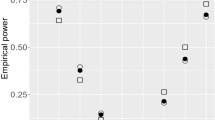Abstract
For an unknown continuous distribution on the real line, we consider the approximate estimation by discretization. There are two methods for discretization. The first method is to divide the real line into several intervals before taking samples (“fixed interval method”). The second method is to divide the real line using the estimated percentiles after taking samples (“moving interval method”). In either method, we arrive at the estimation problem of a multinomial distribution. We use (symmetrized) f-divergence to measure the discrepancy between the true distribution and the estimated distribution. Our main result is the asymptotic expansion of the risk (i.e., expected divergence) up to the second-order term in the sample size. We prove theoretically that the moving interval method is asymptotically superior to the fixed interval method. We also observe how the presupposed intervals (fixed interval method) or percentiles (moving interval method) affect the asymptotic risk.



Similar content being viewed by others
References
Amari S (2016) Information geometry and its applications. Springer, Berlin
Amari S, Cichocki A (2010) Information geometry of divergence functions. Bull Pol Acad Sci Tech Sci 58:183–195
Amari S, Nagaoka H (2000) Methods of information geometry. In: Translations of mathematical monographs, vol 191. American Mathematical Society
Barbiero A (2012) A general discretization procedure for reliability computation in complex stress-strength models. Math Comput Simul 82:1667–1676
Drezner Z, Zerom D (2016) A simple and effective discretization of a continuous random variable. Commun Stat Simul Comput 45:3798–3810
English JR, Sargent T, Landers TL (1996) A discretizing approach for stress/strength analysis. IEEE Trans Reliab 45:84–89
Lehmann EL (1999) Elements of large sample theory. Springer, Berlin
Sheena Y (2017a) Asymptotic expansion of risk for a regression model with respect to \(\alpha \)-divergence with an application to the sample size problem. Far East J Theor Stat 53:187–230
Sheena Y (2017b) Estimation of a continuous distribution on the real line by discretization methods: complete version. arXiv:1709.09520
Sheena Y (2018) Asymptotic expansion of the risk of maximum likelihood estimator with respect to a-divergence. Commun Stat Theory Methods 47:4059–4087
Vajda I (1989) Theory of statistical inference and information. Kluwer Academic Publishers, Dordrecht
Acknowledgements
We would like to express our deepest gratitude to the anonymous referees and Hajo Holzmann, Editor in Chief of Metrika, for their useful advice and comments, which improved the quality of the paper.
Author information
Authors and Affiliations
Corresponding author
Ethics declarations
Conflict of interest
Author declares that there is no conflict of interest.
Rights and permissions
About this article
Cite this article
Sheena, Y. Estimation of a continuous distribution on the real line by discretization methods. Metrika 82, 339–360 (2019). https://doi.org/10.1007/s00184-018-0683-y
Received:
Published:
Issue Date:
DOI: https://doi.org/10.1007/s00184-018-0683-y




